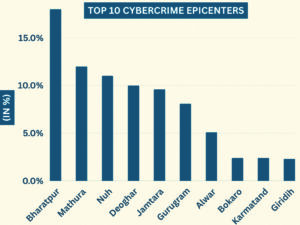
In the era marked by technological strides and digital interconnectivity, cyberspace stands as both a blessing and a challenge. The world’s growing reliance on digital platforms for communication, commerce, and information sharing has given rise to the ominous spectre of cybercrime, casting a shadow over the potential of the digital era.
India, in the throes of rapid digital transformation, stands at a crucial juncture between innovation and vulnerability, contending with a surge in cybercrimes unfolding between January 2020 and June 2023. A recent in-depth analysis of cybercrime trends in the country, conducted by the Future Crime Research Foundation (FCRF), exposes a pervasive and disconcerting pattern.

The comprehensive study, titled ‘A Deep Dive into Cybercrime Trends Impacting India,’ meticulously scrutinizes the period from January 2020 to June 2023. It illuminates the alarming prevalence of online financial fraud, constituting a staggering 77.41 per cent of all reported cybercrime cases during this timeframe. The Future Crime Research Foundation (FCRF), a non-profit startup incubated at IIT Kanpur, specializes in research encompassing cybersecurity, digital crime, fraud risk management, cyber laws, and cyber forensics. The FCRF’s report categorizes cybercrimes into distinct segments, offering insights into the multifaceted nature of this pervasive challenge.
Online Financial Fraud: The Dominant Threat (77.41%)
• Business Email Compromise/E-mail Takeover (0.24%): Though relatively low in percentage, this type of attack can result in significant financial losses and data breaches.
• Debit/Credit Card Fraud/Sim Swap Fraud (11.27%): Card-related fraud remains a significant threat, with criminals targeting card information and SIM cards for unauthorized access.
• Demat/Depository Fraud (0.61%): Manipulating demat accounts for fraudulent activities is less prevalent but requires attention.
• E-Wallet Related Fraud (3.45%): The popularity of e-wallets makes them a target for fraudsters, emphasizing the need for heightened security.
• Fraud Call/Vishing (5.32%): Fraudulent calls and vishing remain a significant threat, requiring users to exercise caution when divulging personal information.
• Internet Banking Related Fraud (9.28%): The prevalence of online banking-related fraud highlights the importance of securing online financial transactions.
• UPI Fraud (47.25%): Unified Payments Interface (UPI) fraud stands out as the most prevalent online financial fraud, signalling a pressing need for improved UPI security.
Online and Social Media-Related Crime (12.02%)
• Cheating by Impersonation (1.71%): Impersonation emerged as a prevalent tactic used by cybercriminals to exploit victims’ trust, highlighting the need for vigilance in online interactions.
• Cyber Bullying/Stalking/Sexting (3.87%): Instances of online harassment and sexting underscore the importance of fostering a safe digital environment.
• Email Phishing (0.13%): Although relatively low, the persistence of email phishing attacks indicates the importance of ongoing efforts to combat this threat.
• Fake/Impersonation Profile (2.38%): Creating fake profiles for malicious purposes remains a common tactic in the cybercrime landscape.
• Impersonating Email (0.03%) and Intimidating Email (0.02%): While less prevalent, these tactics still pose a threat, emphasizing the need for email security awareness.
• Online Job Fraud (0.94%): Job-related fraud exploits individuals’ desperation for employment, necessitating caution when pursuing online job opportunities.
• Online Matrimonial Fraud (0.10%): Deceptive practices in online matrimonial platforms are less common but warrant users’ vigilance.
• Profile Hacking/Identity Theft (2.37%): The relatively high percentage in this category highlights the need for robust online profile security.
• Provocative Speech for Unlawful Act (0.47%): The use of online platforms to incite unlawful activities is a moderate concern, necessitating measures to curb such content.
Hacking/Damage to Computer Systems (1.57%)
• Damage to Computer, Computer System, etc. (0.11%): While less common, intentionally causing harm to computer systems requires attention.
• E-mail Hacking (0.38%): Unauthorized email access is relatively common, necessitating robust email security measures.
• Tampering with Computer Source Documents (0.05%): Altering computer source documents may have significant consequences, warranting preventative measures.
• Unauthorized Access/Data Breach (0.92%): Unauthorized access and data breaches pose a substantial threat to cybersecurity.
• Website Defacement/Hacking (0.11%): Website defacement, while less common, remains an issue to address.
Other Cyber Crimes (8.18%)
The realm of cyber threats extends beyond financial fraud, constituting 8.18% of reported cybercrimes. This category encompasses a diverse array of online threats, showcasing the multifaceted nature of digital risks. As per a BQ Prime report, the Future Crime Research Foundation (FCRF) highlighted that “other notable categories” made up 9% of online crimes. These include online cyber-trafficking, online gambling, ransomware, cryptocurrency crime, and cyber terrorism.
The Deepfake Dilemma: A Glimpse into Synthetic Threats
The Future Crime Research Foundation (FCRF) report delves into the growing influence of deepfake technology in cybercrimes, constituting a modest 0.09% of the total cybercrime landscape. Crimes associated with deepfakes, such as sextortion and synthetic audio-video manipulation, leverage AI-generated content to create deceptive narratives, eroding the boundaries between reality and fiction. Addressing these synthetic threats requires proactive measures to uphold digital trust.
As deepfake-related crimes represent a small yet concerning fraction of cybercrimes, the report underscores the importance of staying ahead of evolving technologies to safeguard individuals and organizations from the potential harms posed by deceptive AI-generated content.
The Imperative for Vigilance and Preparedness
India grapples with a multifaceted cybercrime landscape, primarily marked by the prevalence of online fraud and financial crimes. To counter these evolving threats, a robust approach involving enhanced security measures, heightened public awareness, and collaborative efforts among stakeholders becomes imperative.
The surge in UPI fraud and the emergence of deepfake-related crimes underscore the urgency for India to maintain vigilance and readiness against dynamic cyber threats.
The nation’s digital ecosystem must undergo adaptive measures to ensure the protection of citizens’ digital assets and privacy, fostering a secure digital future.
TOP 10 CYBERCRIME EPICENTRES
Bharatpur, Rajasthan (18.0%)- The high cybercrime rate in Bharatpur may be attributed to its proximity to major urban centres like Delhi and Jaipur, making it a potential hub for cybercriminal activities. Lack of awareness and digital literacy among the population may contribute to vulnerability. Economic factors, such as limited employment opportunities, might drive individuals towards cybercrime as a means of income.
Mathura, Uttar Pradesh (12.0%)- Mathura’s significant cybercrime rate could be linked to its status as a prominent tourist destination and associated financial transactions, making it an attractive target for cybercriminals. Limited cybersecurity infrastructure and awareness among businesses and individuals could exacerbate the problem.
Nuh, Haryana (11.0%)- Nuh’s elevated cybercrime rate may be influenced by its proximity to the National Capital Region (NCR), which attracts both cybercriminals and potential victims. Socioeconomic challenges in the region may contribute to cybercrime as an illicit source of income.
Deoghar, Jharkhand (10.0%)- Deoghar’s cybercrime rate could be linked to insufficient law enforcement resources and a lack of specialized cybercrime units. Limited digital literacy and awareness among the local population may make them more susceptible to online scams.
Jamtara, Jharkhand (9.6%)- Jamtara is infamous as a hub for cybercriminal activities, particularly related to online fraud and phishing. A culture of cybercrime may have developed in the area, with well-organized criminal networks operating from there.
Gurugram, Haryana (8.1%)- Gurgaon’s high cybercrime rate is likely influenced by its status as a major corporate and IT hub, making it an attractive target for cybercriminals seeking valuable data or financial gains. Despite its economic affluence, disparities in digital literacy and cybersecurity awareness may persist among Gurgaon’s diverse population.
Alwar, Rajasthan (5.1%)- Alwar’s moderate cybercrime rate could be attributed to its location between Delhi and Rajasthan, making it a potential transit point for cybercriminals. Limited cybersecurity infrastructure and awareness in smaller towns within the district may contribute to vulnerability.
Bokaro, Jharkhand (2.4%)- Bokaro’s cybercrime rate might be associated with a lack of specialized cybercrime units and resources for law enforcement agencies. Economic challenges in the region may drive individuals towards cybercrime as an alternative source of income.
Karmatand, Jharkhand (2.4%)- Karma Tand’s cybercrime rate may be influenced by its proximity to other districts with higher cybercrime rates, facilitating the spread of cybercriminal activities. Limited access to digital education and cybersecurity resources may leave the population susceptible to online fraud.
Giridih, Jharkhand (2.3%)- Giridih’s cybercrime rate could be linked to its relatively remote location and limited law enforcement presence, making it an attractive location for cybercriminal operations. Lack of digital literacy and awareness may contribute to the vulnerability of the local population.















